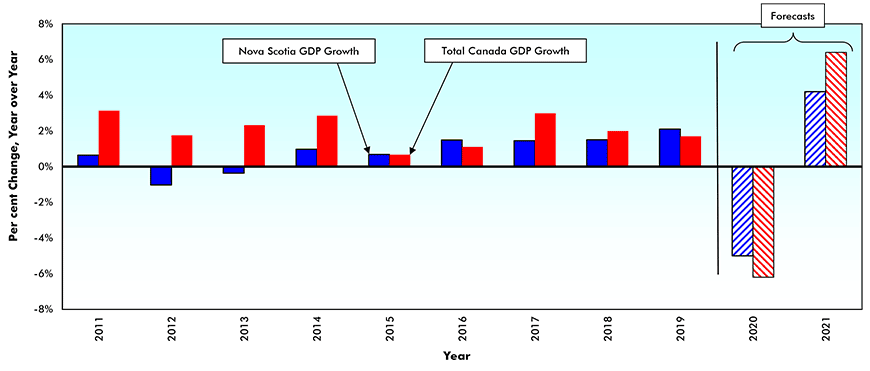With just 20 cases reported since the beginning of June, it is clear Nova Scotia has limited the spread of COVID-19. Although the incidence of the virus in the province, at 1.1 persons per thousand, is the highest among the four Atlantic Provinces, it is well under the national average of 3.3 persons per thousand.
While lockdowns to limit COVID’s spread caused the Nova Scotia economy, along with the rest of the country, to contract sharply in April and May, the province’s relatively low infection rate has enabled it to recover slightly faster than most other provinces. Following back-to-back declines of -10.6% and -3.3% in April and May, the province’s manufacturing shipments jumped by +16% m/m in June, largely due to a rebound in exports of motor vehicle tires, lobsters and lumber, the latter being consistent with the sustained growth of U.S. housing starts.
Hiring rebounds in retail, accommodation and health care
After rehiring 9,000 workers in May plus an unprecedented 30,000 in June, firms in Nova Scotia added a further 3,400 jobs in July. Over the past three months, the province has “clawed back” approximately 54% of the jobs it lost in March and April. As of July, 24,000 of 47,000 laid off full-time workers have been rehired and just under 60% of the 29,000 sidelined part-time workers are back at work. Over the past two months, the province’s unemployment rate has retreated from a high of 13.6% in May to 10.8% in July, just slightly below the national average of 10.9%.
Pent-up demand and surge in hiring fuel consumer spending and home sales
In response to the re-opening of the economy, consumers headed back to the mall in May and June. At the same time, surging employment and recent declines in mortgage rates caused Nova Scotia’s housing market to recover sharply. After plunging by -18% m/m in April, retail sales rebounded +21% m/m in May and by a further +23% in June, due in large part to surging sales of motor vehicles (+52% m/m) and building materials (+32% m/m).
Existing home sales rose +8.2% in April, +44% in June, and by +6.5% in July. Average house prices are up +15.0% y/y, the fourth-highest increase among the ten provinces. Given very strong sales over the past three months that have pushed the months’ supply of homes for sale to a seventeen-year low in July, it is not surprising that applications to build new dwellings rose +10.7% in June, nor that housing starts were up by +115% y/y in July.
While persisting low interest rates will underpin housing demand well into 2021, several factors will likely lead to slower growth of home sales during the remainder of this year and into 2021. First, pent- up demand will probably weaken. Second, net migration which boosted the province’s population by over 13,000 last year, will likely retreat sharply this year. Finally, lingering effects from COVID-19 will probably depress employment growth in a several of the province’s key industries, including tourism, recreation, and entertainment. After hitting a COVID-depressed low of 4,100 to 4,300 units in 2020, we expect housing starts will total in the range of 4,600 to 4,800 units in 2021, close to the level they reached in 2019.
COVID-19 prompts firms to (temporarily?) shelve major capital projects
Negative COVID effects have prompted many firms in Nova Scotia to put their capital spending plans on hold. Initially, in February of this year, Stats Canada projected total public and private capital spending (CAPEX) would increase by +1.4% y/y after retreating by -0.9% in 2019. However, a more recent Stat Can CAPEX survey taken in June and July reported that firms were cutting their spending in 2020 by -6% due to a -17% drop in spending on private sector projects which more than offset a +9% increase in public sector projects.
The Atlantic Provinces Economic Council (APEC)’s Major Projects Inventory report is in line with the Stat Can results. APEC also projected CAPEX to drop by -6% this year. But looking ahead to 2021, the APEC capital spending survey calls for expenditures on major capital projects in 2021 to exhibit a slight gain, in the range of +2.5% to +3.5%. While COVID has caused firms in several major industries, including manufacturing, mining and oil and gas extraction, to temporarily shelve major projects, this hiatus will be partially offset by sustained public sector spending on projects such as the expansion of the Halifax Infirmary and by the Halifax Shipyard Contract to build combat vessels as well as vessels for the Canadian Coast Guard.
Bottom line
To say Nova Scotia’s economic outlook is uncertain is a huge understatement. However, the fact the incidence of COVID-19 in the province has been in single digits for the past two months suggests that it has the tools and the knowledge to prevent a second wave from paralyzing the economy as it did in March and April. Looking ahead, growth in the province should gradually improve due to a slow recovery of tourism, a gradual pickup in exports, and a stronger pattern of international immigration.
John Clinkard has over 35 years’ experience as an economist in international, national and regional research and analysis with leading financial institutions and media outlets in Canada.
Real* Gross Domestic Product (GDP) Growth – Nova Scotia vs Canada

Chart: ConstructConnect – CanaData.











Recent Comments
comments for this post are closed